Evolving 'Polly Wee'
1234
... 11
1234
... 11
|
|
(With my apologies to those who have heard it all before)
Why ‘Polly Wee’? My Honey isn’t keen on her name Ruth, though true to form she tries her hardest to follow me everywhere. During our adventures we have called each other all sorts of things and this is one my better ones. According to the Oxford English Dictionary the word ‘Premise’ is defined as “A statement or idea that forms the basis for a theory, argument, or line of reasoning”. In the never ending quest to improve on the present boat, I wanted a camping, rowable, sailing dinghy that would be simple to build, would sit upright when the tide went out and would be light enough to trolley the half mile from the house to the slip, then back, without rendering me a crumpled heap, puce and gasping, in a corner of the yard. Also, it would be nice if this one were to actually fit in the garage, without requiring a shoe horn. Tall order? Anyway, I set the onboard computer to work on the problem. Sharpies and flatties are proven, single-chine, boats, but are either sharp or flat and often both; I hankered after the perfect pitch. History demonstrates at least two seriously famous flat bottom boats, the Thames barge and the Grand Banks stacking dory. So I had an idea, a ‘premise’ that it ought to be possible to combine the dory’s flared sides with the Thames barge’s relatively longer waterline length and chines softened at the ends. One of the other pedantries I am surely known for, is basing my designs on the size of a standard sheet of ply; one and a half sheets – twelve foot, in this case. Enter the ‘Premise 12’ at twelve feet (3.66 m) round the longest plank – the sides at the gunwales, gives me a couple of feet each end in the garage, to get round; luxury. So that’s the length, but what about the beam? This is just a notion, so you can use the principle and fit it to any parameters that you care to apply. I scratched around and found two good reasons for making her rather slim. Firstly, on occasions I expect to have to row her for long periods and my oarsmen, or maybe I’m their sailor, tell me that a narrow hull is best. Secondly – Bollards! There is a set of them down on River Road  If I am to avoid dressing her in her full road regalia to move her half a mile to the water, then she needs to fit between them – four foot six inches (1.37 m). I took an adjustable mock up of her widest beam and spent a few minutes down there holding it up to the bollards and making adjustments. I think I may be getting a reputation – “That nutter, who’s always pushing his boat around the town, was down by the bollards on River Road yesterday, waving some sticks about.” 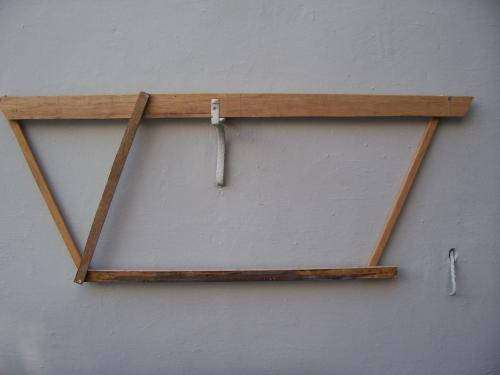 There is more. While she needs to be able to move easily under oar, she is to be primarily a sailing boat so I plan to have a reasonable sail area – eighty square feet in a single unstayed balance lug with one reef, halving the area. That is on a beam of 4’ 6” at those flared gunwales, but there’s worse to come – the floor is only three feet (0.89 m) at its widest, so there has to be another way of achieving stability. The only answer is ballast; unless you know different, this is the only other answer to an adequate sail area and limited beam. As she needs to be light enough to handle ashore, it has to be water – you’re sitting in it and all you need to get it onboard is a hole in the bottom. Controlling the stuff is bit more complicated, so the details will come when we get to the bit about trials. The idea is to tend to row her light and narrow, then admit ballast to sail her heavy – wider still and wider, what flare! I'll keep you informed as I take further faltering steps Chris W |
|
|
Sounds like an interesting plan. I like the idea of water ballast, particularly combined with the flat bottom. A shallow water ballast tank running across the full width of the bottom would be pretty effective at maintaining the naturally good initial stability of a flat bottom as the angle of heel increases.
The only issues I've heard of with water ballast tanks are those of filling and emptying them quickly. It takes some ingenuity to get then to empty quickly and easily, judging from some of the comments I've read about other boats with water ballast. Jeremy |
|
|
This post was updated on .
In reply to this post by Chris Waite
I'll come back to the water ballast nearer the time if that's OK Jeremy
In case anyone has better things to do than make a study of Thames barge ends, here is an old lady who has taken retirement and is softly returning to the mud: 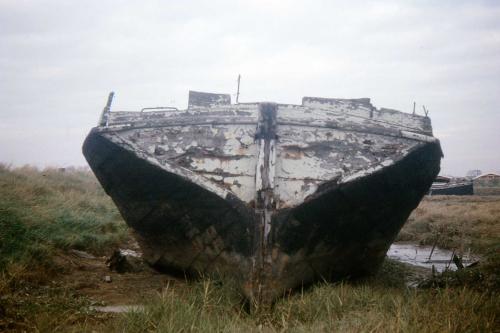 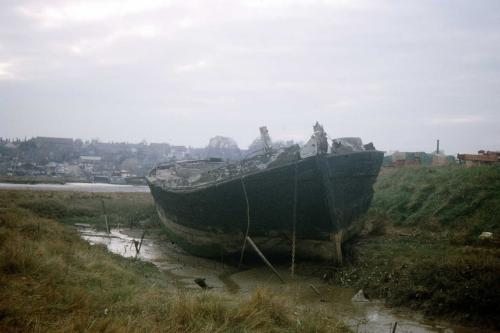 Interestingly she seems to have slightly flared sides as some of them did; I do not think this is simply dilapidation. Here are a few more ends: 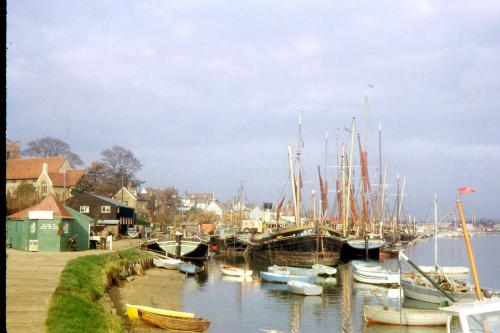 The Grand banks dory on the other hand was designed to be heaped on the decks of the schooners. So imagine a small stack of disposable paper cups, only larger, in wood, with pointy ends; very flared and with extremely raked bow and stern so that once the thwarts were removed they would fit one inside another: 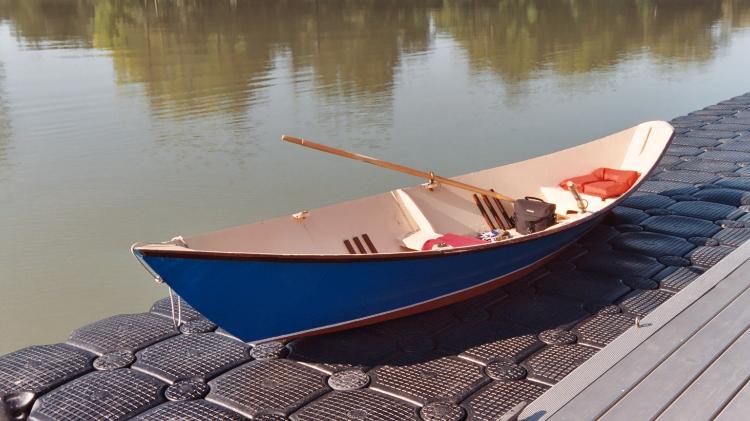 Displacement speed is related to waterline length, so the longer the better for my purposes. To maximise this one should ideally have a hull with a rectangular profile so that the ends are vertical. I just couldn’t bear the associated lack of aesthetics and can also confirm that a very sharp forefoot can not only be awkward to form, but tends to dig in and make turning more difficult. It still needs to be bold, as anything cut away too far, or with a flat floor underneath will slam in a seaway. Once or twice is OK, slamming gets really tedious if continuing for more than a few minutes and tends to slow progress. So I have chosen a reasonably vertical stem with a generous rounded forefoot. This rises to a stem head with a tad of reverse rake. I know, I know, typical CW stuff and enough to cause many to double-take and shudder. Think of Canadian Canoes, curvy Dutch Botters and Galway Bay Hookers; slosh in some ‘Lord of the Rings’ and I think it starts to get rather intriguing, here is the intended profile: 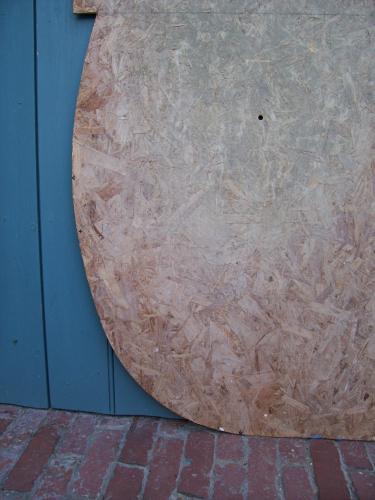 As these builders knew, it also makes sense; while helping protect the rest of the boat from a large sea, any air coming over the bow tends to be lifted over the hull and into the sails. She will have a tall stem for such a small boat and people might mutter “windage” and such; they may well turn out to be the same people who admire the Welsford ‘Scamp’ that has a forward transom tall enough to hide a traditional cuddy and is only five inches longer over all. The next point is that this is not in fact the standard CW forward sections either. ‘Octavia’ and Graham’s ‘Katie Beardie’ are nearly identical to each other; the strakes have been allowed to form a natural rocker as hull takes shape:  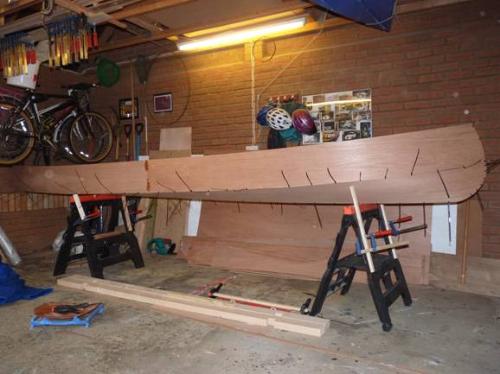 In consideration of the requirement to take the ground this time, rocker forward has been brutally suppressed. I am currently doing ghastly things to the first sheet of 4mm ply; only 4mm? You should see what I am inflicting on it; the formation of the forefoot is the first real construction hurdle: 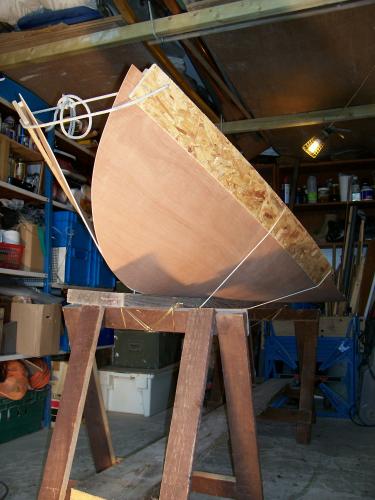 Previously I have tended to let other boats choose their own shape in a cuddly, free-form sort of way, but this time I have lashed a stout board to a couple of trestles. The ply is screwed to the board down the midline with a couple of crosspieces in reducing sizes going forward, then hauled up by its edges supported with a strips of Stirling board, tied across and slowly tightened while being stretched over vertical struts. Bowstrings have had an easier time of it: 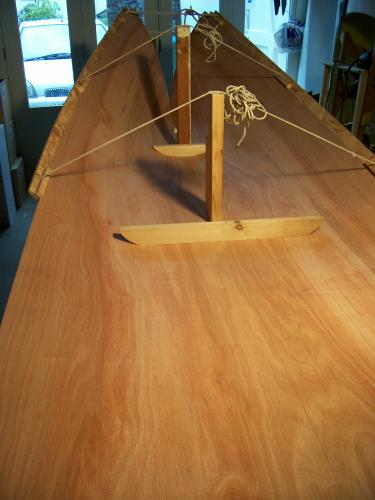 When I started a few days ago, I reckoned I could see by the look of it that it was thinking “Shan’t!”, but actually it is getting there. I tried to heat the stuff as recommended, putting a drop cloth over it and aiming a blow heater through the ensuing tunnel, but it was quite apparent that the house would be a smouldering pile of ash before the wood ever got hot enough to loosen its Resourcinol and cellulose cross-bonds. Maybe a hot air gun. If you hear a faint ‘crack’ and a distant howl of despair carried on the wind in the next little while, you’ll know that the ply is not as flexible as I had hoped. CW |
|
|
That's an excellent post Chris - very interesting to see the old barge profiles. I noticed in the second picture she is slightly fuller midships like the Coble almost. That would get the C of G a tad lower for extra stability.
Your link mid-post needs fixing a tad, were you trying to add another photo? The link is actually for a reply so summit went wrong....send me the details and I can edit the post for you. |
|
|
Paulie, that link
Was meant to be to your posting on the Gloucester Light Dory, June 24th, in the topic 'The Perfect River Raid Boat', under General discussion. I thought I had cracked the link bit, but it is obviously beyond the intelligence of this time-expired quack. I think the camera angles and the fact that the old barge's forward sections are just starting to roll into the bottom of the creek are misleading. Imagine a loaf tin (ask the Missus), with ends as in the pictures. These were load carrying vessels and though those ends are quite subtle and some had the subtleties carried through the midships sections, they were based on rectangular boxes with shapely bits stuffed on the back and front CW |
|
|
In reply to this post by Paul H (admin)
Thanks Chriss for reminding me on how interesting it can be to observe the ends of old ladies.
 Its an interesting build. I´m looking forward to the rest. Its clearly something different. I would continue to pour boiling water over a towel on the inside of the hull while torturing the ply. It worked very well for me when twisting the garboards of the Thames skiff. I´m perfectly aware that your new build is torturing the ply a lot more. I dont agree that boiling water will only affect the outer layer(s) The ply is WBP, but it doesnt mean that water wont penetrate to the inner layers of the ply. It only means that it wont fall apart if boiled. And besides, its the heat that matters the most. The ply looks very nice. Is it the cheap wbp you just bought? |
|
|
So tell us Anders, from the Thames 12 rowing pictures, are you the young stud with the well insulated chest, lovingly admiring the oars, or are you the steel-grey haired dude with the Scotty dog attached to his ankle? The reason I ask is that on reaching a certain age, “to observe the ends of old ladies” is about all one can hope for and I wondered if you were like me, speaking from experience; or is it simply kindness?
Anyway, it is the ply in question and I’m glad it looks nice, because a tale hangs thereby. Eventually it was persuaded to come together  Got it cracked you reckon? But no; there was certainly a substantial click or two in the final stages and a sort of subtle lump under where that first lunate (moon-shaped) cross-brace screwed down - see the picture in my last posting and what you can see above is only the floors forming the forefoot; the topsides have still to go on above that. In fact I took it all apart again. I am after a tad of reverse rake, but not below the chines please: she's meant to ride over waves, not plough through them. While I had cut out the bow profile, as the bow is actually made up of floors tortured in from an angle, I cut the profile in expecting to have to trim it back. 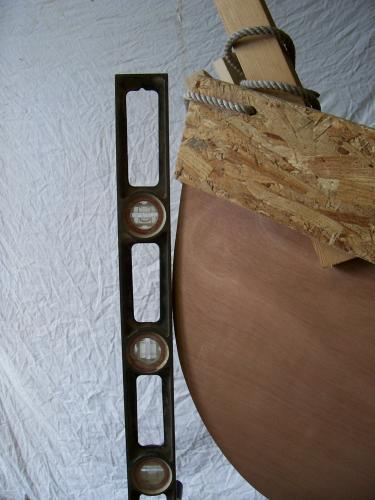  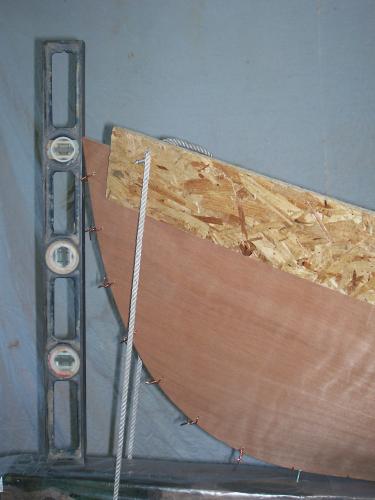 It might have been possible to form the shape over a ‘male’ profile, but that would have meant either turning the whole thing upside down (and it is difficult enough to think the right way up), or having the former fixed to the ceiling. There’s already a rack of junk up there and I need to be able to move the creation around just to be able to get at the other side of the garage, so that’s a non-starter. Forcing ply into a ‘female’ former is a mug’s game; anyone who knows better come on over and I’ll hold your coat. This bow has to have a smattering of artistic licence about it. 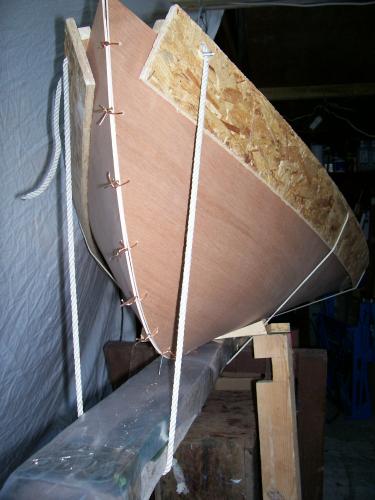 I re-cut it, perhaps a smidge enthusiastically, though there is still some to spare. The other problem is the amount of torturing that has gone on under the forefoot has, as intimated above, opened up the odd splitulette in the outer laminates – hence the pit prop and wedge. To explain, I warmed it all up with the hot air gun on ‘high’ after I persuaded the forefoot together a day or so ago, though I was aware that something had stirred. I happened to come down to the garage in the cool of the subsequent evening to the sound of a couple of minor reports and as I feared it was an extending problem, so I rushed to the breach with baulks of timber and managed to stop the dissolution. Once I have thought of a way of getting in there with gobs of epoxy and some sort of flexible strap covered in suitably non-stick polythene, I shall foist it back into place. After all, the hull floor thereabouts will have a layer or two of glass mat and Tesco’s finest bed linen (polyester-cotton sheets) epoxied over that, plus something stout for the inside, as it is approximately where the mast should be footed. However I do wonder if for ever after, I will wonder if the mast might exit through the bottom of the boat at some moment of interest? That’s only part of it; how do you persuade tortured ply to stay in its excruciating shape once it has been released from the trap? The ply story gets better. I pulled out the next piece in the morning sunshine and happened to notice the maker’s stamp in a corner; it’s three mm. not four. Ooooh ‘Covers’, you dirty rotten scoundrels. What is more the six mm. is five point five. This wood is getting more and more to the point where it becomes a retained former. Anders, unless you are a raving Anglophile, there is no reason why the next bit should mean anything to you, but Monty Python’s Parrot sketch crept upon me. Actually there's really no point in anyone reading beyond here as there's nothing remotely boaty about it; I'd wait for the next post if I were you: Me: I wish to make a complaint. Covers: Sorry, we’re closing for lunch. Me: Never mind that my lad, I wish to complain about this ply, what I bought not a month ago, from this very wood yard. Covers: Oh yes, the four mil; what’s wrong with it? Me: I’ll tell you what’s wrong with it, it’s three mil. That’s what’s wrong with it. Covers: Nah, nah, it’s nominal, look… Me: Look, my lad, I know a size-stamp when I see one and I’m looking at three mil. right now. Covers: Nah, nah it’s not three mil. it’s nominal. Me: Nominal? Covers: Remarkable ply, the four mil. Beautiful veneers, aren’t they? Me: The veneers don’t enter into it, it’s three mil. Covers: Nah, nah, it’s nominal. Me: Alright then, if it’s nominal, why’s it say three mil? Covers: There…. it says four mil. Me: No it doesn’t, that was you writing on it in pencil. Covers: I did not. Me: Yes you did; now that’s what I call a con. Covers: Nah, nah, it’s mislabelled. Me: Look my lad, I’ve had just about enough of this. That ply is definitely three mil. and when I bought it, you assured me that it’s lack of thickness was due to it being pressurised and ironed-out after some time in a woodpile. Covers: Nah, it’s got to be pining for the forests. Me: Pining for the forests, what kind of talk is that; look, why did it crack-up the moment I used it? Covers: Four mil. prefers being used flat. Beautiful ply, lovely veneers, aren’t they? Me: Look, I took the liberty of examining it and found that the only reason I couldn’t see the stamps in the first place, is that you’d turned the whole stack over. Covers: Of course it was turned over, otherwise the wind could have got under it and voom! Me: Look matey, this stack wouldn’t voom unless a hurricane had knocked your shed over; it’s bleeding mis-sold. Covers: It’s not mis-sold, it’s pining. Me: It’s not pining, it’s skimped, this plywood is under sold, it is missing a millimetre, it’s laminates are miserly, it is a thin sheet, it’s a con, bereft of size, it’s short a piece. If you hadn’t inverted the pile, everyone would know; it’s paltry poplar, any reference to this being four mil. is from henceforth inoperative. Covers: Well we’d better replace it then. Me: If you want to get anything done in this country, you’ve got to complain till you’re blue in the mouth. Covers: Sorry Gov, we’re right out of four mil. Me: I see, I see, I get the picture. Covers: We’ got PVC fascia. Me: Does it bend? Covers: Not really, no. Me: Well I’ll take that then CW |
|
|
Even though I´m not anglophile, I did keep on reading until the last word. Your posts are always a good lesson in understanding the English language.
 Its an interesting build and I´m looking forward to some more. Maybe you have succes because of the 3 mil. Maybe those at Covers knew better. They were kind to you when they sold you 3 mil because maybe they knew that you would fail with 4 mil. Just add a layer more of fibreglass cloth and call it tortured composite construction. It sounds very modern and fancy. BTW, I´m the one with the hair turning grey, so this with observing the ends of old ladies is just me preparing my own future. |
|
|
You're a brave man Anders; here is the original "Parrot Sketch":
http://www.youtube.com/watch?v=npjOSLCR2hE You know of course that we Brits are mad, but then we were invaded by Vikings a while ago now. I hear some of them even got as far as Spain - nice bows on those longships Chris |
|
|
Sergent Major (admin) talking -
"This sketch is getting too silly, far too silly..." "Bring on the dancing vicars" |
|
|
In reply to this post by Chris Waite
Ahh I know the sound of cracking ply so well. Hot soggy towels dear boy, hot soggy towels!
I love the way you build boats, they're not kidding when they call it tortured ply, I'm sure I saw our old friend the Spanish Windlass in there somewhere. I think the sterling board gunwales really set her off. Anyway been to the boat show today so here's one for you guys who like to look at ladies stern quarters. 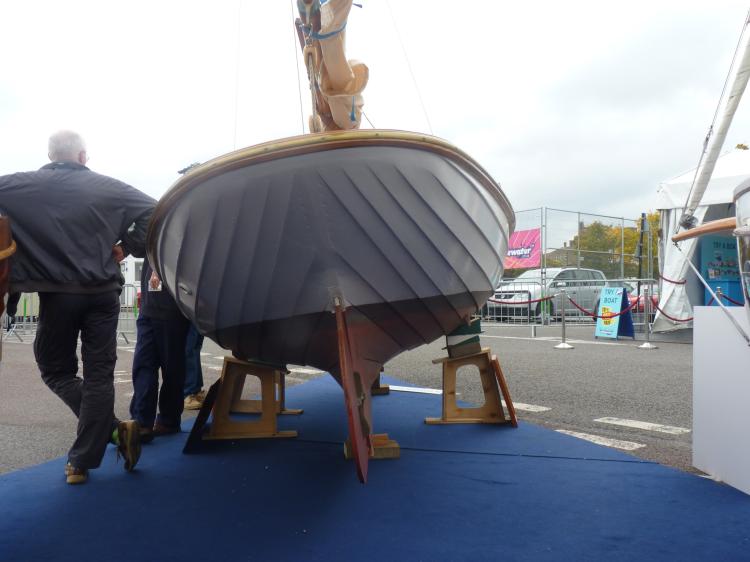 |
|
|
¡¡¡¡This is a late parrot!!!!
My stepdad was from Northumberland and we wached the monty Python and later that John Cleese show from the hotel (cant remember the name) on danish telly and he taught me some english/scottish culture. (He was a Harris) So I know the sick absurd UK humor. That I like. Its a good thing and there are quite a few crazy islanders running around. BUT there are also a lot of very mainstream "nice cuppa tea my dear" hollowheads around and the worst is the cynical, negative islander. But I think its like that everywhere. Graham. Thats a really sweet old lady rear part you found there. 
|
|
|
OK My Hearties
At the whim of the Minister of the Interior, I am to report for other duties for a while. So there will now be a Short Intermission Till soon Cee Dubbaya |
|
|
ohhhhhhh
 I like this thread. Because I dont know what is going to happen. |
|
|
Anders wrote: "I like this thread. Because I don't know what is going to happen."
(Psssst, Anders; Neither do I. CW) |
|
|
So just one thing: How do you make things happen. Drawings, computer or just the good ole glue and cut tecnique?
|
|
|
I have apparently performed my duties to the satisfaction of the Minister of the Interior; though not actually decorated for bravery or anything, I am once more a free man – well moderately at least.
So Anders, how do I make things happen? It’s a good question. I spend an inordinate amount of time thinking about the project; mostly lying awake in the wee small hours. Though like the chicken and the egg, whether the wake or the think comes first, I couldn’t tell you. However, it means that I have already handled this boat under sail and oar and camped out of her, long before the first ply sheet is ever even adulterated. The original idea has been modified backwards and forwards – everything, the shape of the transom, how the water ballast will work, which side for the bunk, etcetera, etcetera and the build has taken place, at least vaguely – loads of times; all stored between the ears for use later. Actually, which side for the bunk is a good example. I am right handed, so things like making sail, or handling anchors come more naturally to Starboard when facing forward. If I have to do this in a hurry (from a deep sleep for instance), then it would be more convenient to have the bunk to Port out of the way; however there are other factors. If this is not too much information, my Honey and I sleep mostly back to back with me lying on my right side, but it used to be the other way round until she directed a change due to a painful right hip. Are you with me so far? Lying comfortably is easiest in a narrow bunk on a dinghy if your back is to the hull; so far all points lead to Port, but. To Starboard means that using your right hand to haul yourself vertical from a saggy hammock-berth is easier and the best space for galley work and such comes more naturally to hand. The reason I know this is that the bunk on Rosie Mae is to Starboard; why? Well, I was going to make it interchangeable, but the six inch hatch in the forward bulkhead is to Starboard of the mast, thus I could only reach that side to bolt in an eye to take the forward outboard corner of the bunk net. Finally, I have had problems with some naughty neck discs and I think my right arm has been somewhat weaker for the last few years, though I feel any difference is becoming less noticeable. This is the sort of weird process my mind I concocts for every aspect of the design; currently I'm bunking to Port, but watch this space for other factors. After the thinking, I make a cardboard model of the hull directly from inside my head and then an approximate plan, with enough details to shape and locate the sail and centreboard to get the CoE and CLR properly related to each other. The thinking continues while building, but as the process struggles forward, I make (hopefully minor) modifications to allow for reality. There just does not seem to be any point in fighting to force something that is already in my mind through the contortions of some conceited computer programmer’s limited understanding of my requirements, just to have to drag them out again. I made the model, in fact two in this case; Admin. Paulie now has the original cardboard one and the grey-painted wood version is sitting up on the window sill above the door. After a ballasted swim in the bath, it has explained to me that if ‘Polly Wee’ and I and the water-ballast and some kit weigh maybe three hundred kilos altogether, then she will have a hull draft of perhaps seven and a half inches, say most of twenty centimetres. That then will be a good level to locate the lowest point of the transom, so that it is just stroking the water when under sail in ballast. I suppose the answer is I cut and glue my way along, but as you can see, the forefoot and I have already had to make several mutual dispensations and that’s only the first piece. Right; onto the sides Chris |
|
|
So, putting it short: You are using mental preparations?
 I´m looking forward to some practical updates. |
|
|
Up I pop again
Like a piece of old jetsam Yes Anders, in short - big think and bundles of blunders; this ply has some interesting properties and many of them I could do without. So with the usual interruptions, over the last couple of weeks I made the ‘sides’ – a couple of two by twelve foot rectangles, with a butt join one third of the way from the bow, where the curve in the topsides is least. It is joined with glass tape – well why not, it’s good enough for the chines and things? The only thing it is not good enough for, is to wave around all twelve foot while being held at the join; well bother Anyway, I started to set them up and quite soon the garage disappeared in plywood halls: 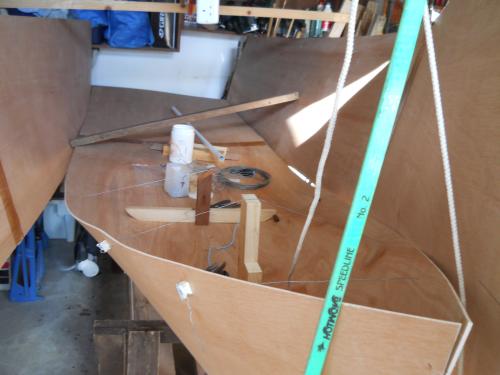 Next was to set them up to the full height of the bow and pencil in the curve of the stem with a batten strapped round the forefoot and extending on up to the height of the head. Then they had to come off to be trimmed round the stem pencil line and my favourite ‘fair curve’ at the chines to match the floor forming the forefoot…. and back on again; with some temporary inwales for support…. and finally stitched up. Please ignore the battens lashed round the chines – there to encourage the shape of things to come, but here is the bow, nose to nose with the original template I cut out, (remember the earlier picture?):  And here she is taking her first curtain call at the garage doors: 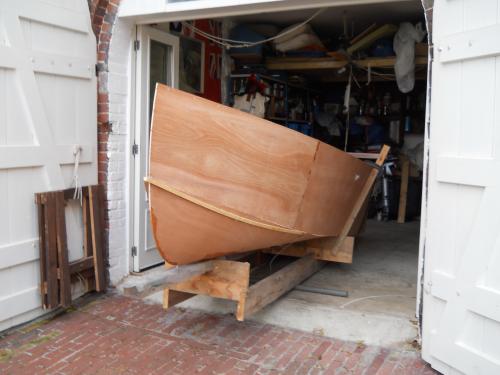 And here outside:  Turned around:  And now time to trim the tush CW (Flimsy, innit?) |
|
|
Interesting......
Will you be able to reverse engineer some bulkhead shapes? That must help folk who decide to build her. -Paul |
«
Return to Builds in Progress
|
1 view|%1 views
| Free forum by Nabble | Edit this page |

